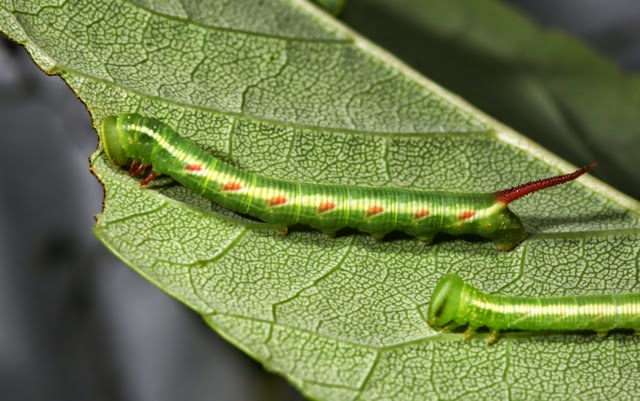Several years ago, Adam Millsap sent me the picture of harlequin bug eggs like those above on the underside of his kale at Urban Farm just a few blocks southwest of the Springfield square. They are stacked together in bunches of 8-10 like miniature barrels. As he noted, they are so beautiful that he hated to crush them, but as he grows veggies for a living, crush them he must.
Only the adult survives over winter. They emerge early in the spring, just as we are preparing our gardens. They lay around 12 eggs together in a line resembling a row of kegs with black hoops. The eggs hatch in 4 to 28 days depending on the temperature.
 |
| Harlequin bug nymph-ventral - REK |
 |
| Harlequin bug nymph - REK |
The nymphs go through 5 to 6 cycles (instars) before they become adults.
These stages progress from pale orange to black with distinct orange and
white decorations. The sexually mature adult develops the most showy
colors. They are 3/8 inch long, a flattened oval shape with crossed
wing covers forming a "V."
 |
| Even their belly is beautiful - REK |
 |
| Adult harlequin bug - REK |
The
harlequin bug (Murgantia histrionica) is a serious pest which attacks cabbage and related species preferentially, although it is capable of attacking almost any garden crop and even fruit trees. Unlike beetles which chew leaves, they suck the juices which tends to kill the whole plant.
 |
| Adult harlequin with a single egg - REK |
Brightly colored insects are frequently advertising that they are bad tasting or toxic (think Monarch butterfly). This is called
aposematic coloration the bird version of a skull and crossbones sign. While sometimes insect color is deceptive, the harlequin bug eats crucifer plants (cabbage, brocolli, etc.) and not only absorbs their
glucosinolates which are toxic to birds, but is able to concentrate and store it within its tissues. I can just hear a mama harlequin saying, "eat your veggies or a big bad bird will get you!"
These are a type of stink bug, so pinching them with your fingers may come at an olfactory cost. Of interest, the harlequin bug originated in Mexico and was first reported in Texas in 1864. Its progress northward was followed and reported through the turn of the century and it now occurs across the US, generally south of Colorado and Pennsylvania.
Hand picking the bugs, larvae and eggs may prevent the recruitment of large armies requiring chemical measures. Given their destructive habits, I can forgive Adam for destroying this mobile form of art in his garden.
More at this link.
Note:
Some gardeners use
"trap crops" such as cleome to attract harlequin bugs away from their other plantings. Commercial growers use
mustard species.
====
Temperature can affect the coloration of the instars. See
Entomologytoday.
I want to acknowledge all the "amateur" naturalist photographers like those above who post their works on Bugguide.net and graciously allow us to use them. Much of the entomological identification and public education is being performed by passionate non-professionals like these.





























